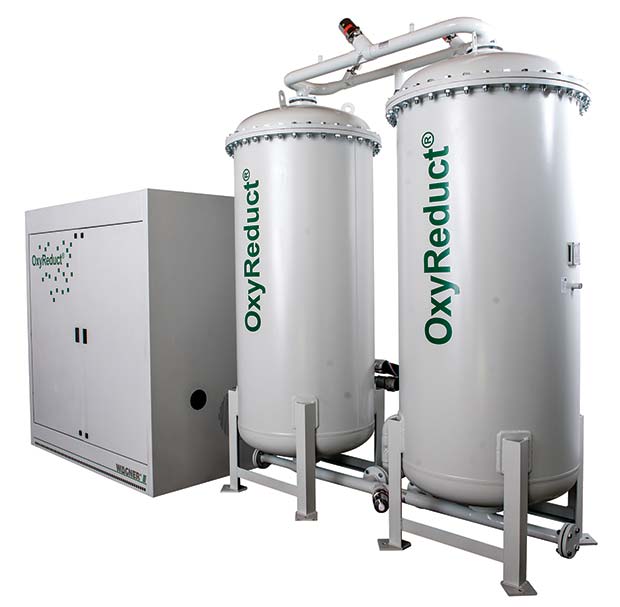As an innovative solution and system provider, based in Bishop Stortford near Stanstead, WAGNER UK Limited specialises in fire prevention and early fire detection.

Research and development work is driven by the high standard of quality as well as the constant strive for improvement and perfection. Already more than 700 patents are the result of this work. World-wide, WAGNER is technology leader in the fields of fire detection and fire prevention. Unique within the fire protection industry, Wagner provides a comprehensive range of goods and services from engineering and design via installation through to after-sales service for its customers.
WLN – As a leading supplier in the Warehouse Safety & Compliance category, what has the last year been like for your business? How about for the rest of your sector?
The past year has been extremely positive for Wagner UK. We have experienced an increase in construction activity and associated enquiries which is driving an increased demand for detection products and project activities in fire prevention services.
WLN – What are your best-known products and services?
Effective protection is offered by:
• Very early fire detection TITANUS®
• Active fire prevention OxyReduct®
• Fire extinguishing FirExting®
• Hazard management system VisuLAN®
WAGNER‘s fire protection solutions are based on these four approaches. Even when combined, they are planned and designed specifically for each customer’s application, environment and building.
WLN – What makes you the first choice supplier in your field?
First and foremost our knowledge and engineering experience sets us apart from others in the market. WAGNER offers its solutions and expertise world-wide.
Our customers not only benefit from reliable, German engineered fire protection systems, but also receive excellent local on-site support and advice.

WLN – What new products and services have you introduced?
We have introduced the latest Vacuum Pressure Swing Adsorption (VPSA) technology. This production method enables high volumes of nitrogen to be generated which is ideal for protecting large spaces such as warehousing and cold storage. The VPSA system can generate energy savings of up to 80% compared to membrane technology.
WLN – What industries are your customers in?
Our customers in the main fall into three vertical sectors – IT (Data centres), Logistics (Automated Warehousing & Coldstorage) and Cultural (Museums and Archives.)
WLN – How do your products and services help customers become more efficient, greener or work safer?
By its very nature, OxyReduct assists logistics operators ensure business continuity and improve fire safety by preventing fires.
Furthermore, from an environmental perspective, the nitrogen needed to reduce the level of oxygen, is produced on site, from the natural ambient air which negates the need for any chemical gases
WLN – Can you tell us about some of your customers and the work you do for them?
The British Library and Library of Birmingham are amongst our most prestigious customers. Although this may not at first appear relevant to the logistics sector, the facilities we protect at the British Library site in Boston Spa operate identically to those operations found within automated warehouses.
WLN – Is there a recent or current project that stands out as a showcase for your company? Can you tell us about it?
We have protected two large automated facilities including a book store and newspaper store for the British Library at their Boston Spa site. The £26m Additional Storage Program was brought into service in December 2008. The UK’s “printed treasures” are kept safe, in more than 100km of shelving. The total storage capacity of 85,000 m² is split into two areas of 35,000 and 50,000 m² each. In both areas books – many historical, periodicals, magazines and other mixed media are stored in about 140,000 barcoded plastic containers in automated high-rack stores that reach 25 m high. As cranes retrieve containers the need for personnel within the storage area is eliminated. The £33m Newspaper Storage Building was successfully brought into service during February 2014 after three years of construction.
The Newspaper Storage Building holds the National Newspaper Collection and contains newspapers from about 400 years ago. They are stored in stacks on metal trays, retrieved automatically by a computerised picking system.
The Additional Storage Program with its two areas that total up to 85,000 m² has been protected by WAGNER’s OxyReduct® technology as well as TITANUS® and VisuLAN®. This combination of active fire prevention, earliest fire detection and a hazard management system leads to a broad and effective fire protection solution.
OxyReduct’s® fire prevention membrane technology reduces the oxygen content in both areas inside the automated high-bay storage. This is done by continuously introducing nitrogen to both areas. The oxygen concentration is therefore constantly lowered to between 14.8 – 15 vol%.
![Stammhaus-alt[13]](https://warehousenews.co.uk/wp-content/uploads/2015/12/Stammhaus-alt13.jpg)
WLN – What were your company’s biggest achievements in the last 12 months?
We have seen substantial growth in our TITANUS® products during 2015 and have also consulted with logistics operators on a number of large scale projects.
WLN – What are you doing to bring on new talent and raise skills levels in your company?
We constantly invest in our employees by providing training and encouraging selfdevelopment.
As a knowledge based business we need the very best skilled and motivated employees to consult with our customers and provide them with the best possible solutions.
![]() WLN – What are the major issues facing the Warehouse Safety & Compliance category as we go forward? How is your company addressing them?
WLN – What are the major issues facing the Warehouse Safety & Compliance category as we go forward? How is your company addressing them?
I believe that the current trend to consolidate logistics operation to a single automated location provides optimum efficiencies, but brings about new challenges in fire safety. Such locations tend to be automated meaning that the cranes and conveyors inherently provide an ignition source. Additionally such building can be built to heights of 30 – 40m and contain tightly packed goods to maximise storage space. This combination equates to a new type of risk not present in ‘traditional’ low bay, manual warehouses which requires consideration over and above the ‘traditional’ methods of fire protection.
WLN – What other big news from WAGNER can our readers look forward to reading in Warehouse & Logistics News in 2016?
We are currently working on securing a number of key projects within the Logistics sector and we hope to bring you updates during 2016.
0370 333 6116




Comments are closed.